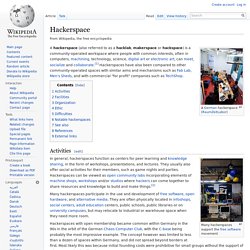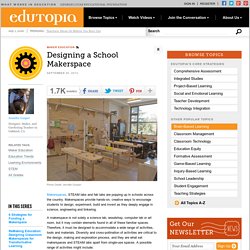

Hackerspace. Activities[edit] Many hackerspaces participate in the use and development of free software, open hardware, and alternative media.

They are often physically located in infoshops, social centers, adult education centers, public schools, public libraries or on university campuses, but may relocate to industrial or warehouse space when they need more room. Hackerspaces with open membership became common within Germany in the 90s in the orbit of the German Chaos Computer Club, with the C-base being probably the most impressive example. The concept however was limited to less than a dozen of spaces within Germany, and did not spread beyond borders at first. DIY projects, how-tos, and inspiration from geeks, makers, and hackers.
Hsmakerspacetoolsmaterials-201204.pdf. Designing a School Makerspace. Makerspaces, STEAM labs and fab labs are popping up in schools across the country.

Makerspaces provide hands-on, creative ways to encourage students to design, experiment, build and invent as they deeply engage in science, engineering and tinkering. A makerspace is not solely a science lab, woodshop, computer lab or art room, but it may contain elements found in all of these familiar spaces. Therefore, it must be designed to accommodate a wide range of activities, tools and materials. Diversity and cross-pollination of activities are critical to the design, making and exploration process, and they are what set makerspaces and STEAM labs apart from single-use spaces. Www.iteea.org/EbD/ebd.htm. The International Technology and Engineering Educators Association's STEM±Center for Teaching and Learning™ has developed the only standards-based national model for Grades K-12 that delivers technological literacy in a STEM context.

The model, Engineering byDesign™ is built on the Common Core State Standards ( High School / Middle School), Next Generation Science Standards (K-12), Standards for Technological Literacy (ITEEA); Principles and Standards for School Mathematics (NCTM); and Project 2061, Benchmarks for Science Literacy (AAAS). Additionally, the Program K-12 has been mapped to the National Academy of Engineering's Grand Challenges for Engineering.
Using constructivist's models, students participating in the program learn concepts and principles in an authentic, problem/project-based environment. Through an integrative STEM environment, EbD™ uses all four content areas as well as English-Language Arts to help students understand the complexities of tomorrow. Creating a space for young makers and educators.